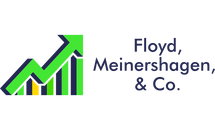|
|
by Lorne Meinershagen, Floyd, Meinershagen, & Co. Nobody looks forward to estimated tax payments, but paying more than necessary is even worse. When freelancers and business owners miss or underestimate their tax liability, the IRS charges them interest and penalties.
The penalty for estimated tax underpayment is calculated and assessed separately for each payment period. Therefore, taxpayers may owe a penalty for a previous period even if they later pay enough estimated tax to make up for the previous underpayment. As a reminder, estimated tax is the method used to pay tax on income that is not subject to withholding. This income includes earnings from self-employment, interest, dividends, pensions and alimony. Estimated taxes are required when your total year-end liability is greater than $1,000. To avoid IRS penalties, most self-employed taxpayers must ensure all four estimated tax payments add up to the lesser of these two amounts:
Understanding your tax liability can be complicated, since you have to take into account fluctuating income, peak business seasons, planned equipment purchases, employee bonuses, new benefits plans and other variables that affect taxes. Tax experts recommend reassessing your finances in the third quarter before making the last two estimated payments for the year – due September 15, 2019, and January 15, 2020 – to gauge any income variations since your last payment or changes that could affect the amount of taxes you will owe for 2019. If your CPA or tax advisor has not contacted you about a tax-planning session, be proactive and schedule time to discuss how to minimize the amount of taxes you will owe on April 15. A good accountant can help you determine whether the best way to achieve your financial goals is to accelerate, defer or reduce your taxable income for this year. Keep these tips in mind as you prepare to make the last two estimated tax payments for 2019:
For expert advice on how to lower your tax liability in a free initial consultation, please contact Floyd, Meinershagen & Co. in Grain Valley at 816-847-0536, or visit www.floydmeinershagenandco.com to schedule an appointment. Many taxpayers were surprised to learn they were getting a smaller refund than in prior years – or worse, that they owed money – when they filed their 2018 tax returns.
And while it may have seemed like they were getting back less money than they had in the past, most taxpayers actually paid less in taxes in 2018 than they did in 2017. That’s because the IRS updated the Federal withholding tax tables in January 2018 based upon tax cuts in the new tax law. The change effectively gave everyone their tax refunds early by withholding less from paychecks, which resulted in lower refunds at the end of the year. If you like getting a refund, you need to change your withholdings as soon as possible so you will have more paid in by the end of the year. Since it’s already June, however, remember you will only see half the impact of withholdings changes on your 2019 tax return. Keep in mind, too, that a refund means you have given the government an interest free-loan. That said, many taxpayers use their tax refund as a savings account, because they know they tend to spend the money they receive in their paychecks. There are other ways to save as well. Many employers offer other opportunities to transfer money to a savings account via payroll deduction, so you never see the money. And if you choose an interest-bearing savings account, your money will grow faster than if you “loan” it to the government on an interest-free basis. Be sure to consider all of your options for savings and adjust your withholdings accordingly. If you need to save more money, take action now one way or another. Change your Federal withholdings, or set up a payroll deduction to a savings or other account. Before you change your withholdings, consider consulting with a certified public accountant because every taxpayer’s situation is different. Here’s an example: If you receive paychecks biweekly (every two weeks) and asked your employer to deduct an additional $50 per paycheck, you would pay in an additional $1,300 over the course of a year. Put another way, you would increase your refund by the same amount: $1,300. But remember, you would only see half of that for your 2019 return, or approximately $650, since the year is half over. If you would like some help adjusting your payroll withholdings or learning how to maximize your earnings, please contact Lorne Meinershagen, CPA, at Floyd, Meinershagen & Co. (FMC): 816-847-0536 or [email protected].  by Daniel Strader, Vice President & Loan Officer, State Bank of Missouri The New Year holiday creates a feeling of starting fresh and encourages us to set new goals. While diets come to mind, setting new financial goals should be on the top of our lists. As you reflect on the past year, focus on your experiences – build on what worked and what didn’t – to shape this year’s money habits. Here are some ideas to consider as you set your financial goals for the New Year.
New Year, New Savings Account Think about what you want to save for the coming year and commit to opening a savings account to reach that goal, whether it’s creating an emergency fund or setting money aside for your kids’ future college tuition. There are many types of savings accounts available to save for both short term and long-term goals. A great tip is to decide on the type of savings account that will meet your goal and commit to depositing a set amount on a regular basis to get into the habit of saving. For example, if you open a basic savings account, deposit $25 every month and sign up for direct deposit or automatic withdrawals from your checking account to ensure that amount is saved. Once you’re comfortable with saving a small amount consistently, you can increase it. Pay Down That Old Debt in the New Year Confronting your debt and thinking about how to pay it off can be scary and overwhelming. Use the New Year to face your fears. Make a list of your debts, noting the monthly payment, current balance, and interest rate, and make a plan to start paying down the debts. Many experts recommend focusing on either debts with the highest interest rates or debts with the lowest balances to pay off. While you will likely save more money paying off debts with the highest interest rates, it may be faster to pay off the smallest balances first and seeing this progress may help keep you motivated. Whichever method you choose for paying down debt, start by adding a small amount to one of your current payments. For instance, if you are focusing on paying off a credit card with a minimum monthly payment of $100, add $25 to that amount to start (for a total monthly payment of $125). Once you are comfortable with that new amount, add more when you’re able and stay focused on the goal. Get Organized Keeping your finances organized will help you control your money and achieve your financial goals. Some basic tasks to help you get organized include making a budget, tracking your spending, and putting a system in place to ensure you pay your bills on time every month. Be sure to monitor your credit card and bank statements for any unexpected fees or unusual activity too. The sooner you find mistakes or unauthorized transactions, the easier it is to correct those issues. Like dealing with debt, organizing your finances can be daunting, so start small by picking one organizational task and focus on that task for one month before adding another. For example, you might start by making sure your bills are paid on time by setting up automatic bill pay from your bank account, giving yourself one month to learn about it, set it up, and get comfortable using it. Next month, focus on creating a budget, which gives you several weeks to learn about budgeting and working on it. Protect Your Money All Year, Every Year With so many financial transactions occurring electronically, it’s important to proactively protect your personal information, including your credit card and bank account numbers. Use the New Year to take charge of protecting your money. Never provide your personal information in response to an unsolicited request, whether it is over the phone or over the Internet. Always track your bank and credit card statements and your credit reports for unusual activity. Catching abnormal transactions early will allow you to take steps to prevent more harm if your information has been stolen. State Bank of Missouri is happy to offer several savings accounts to fit your new year money management goals. We also offer free online and mobile management services for saving and budgeting including our Mobile App for Android and Apple devices and the CardValet app for real-time debit card monitoring. Visit with a member of the State Bank of Missouri team today to learn more or online at www.gostatebank.com. Member FDIC |
Categories
All
Archives
July 2024
|
Grain Valley NewsGrain Valley News is a free community news source published weekly online. |
Contact Us |



 RSS Feed
RSS Feed
